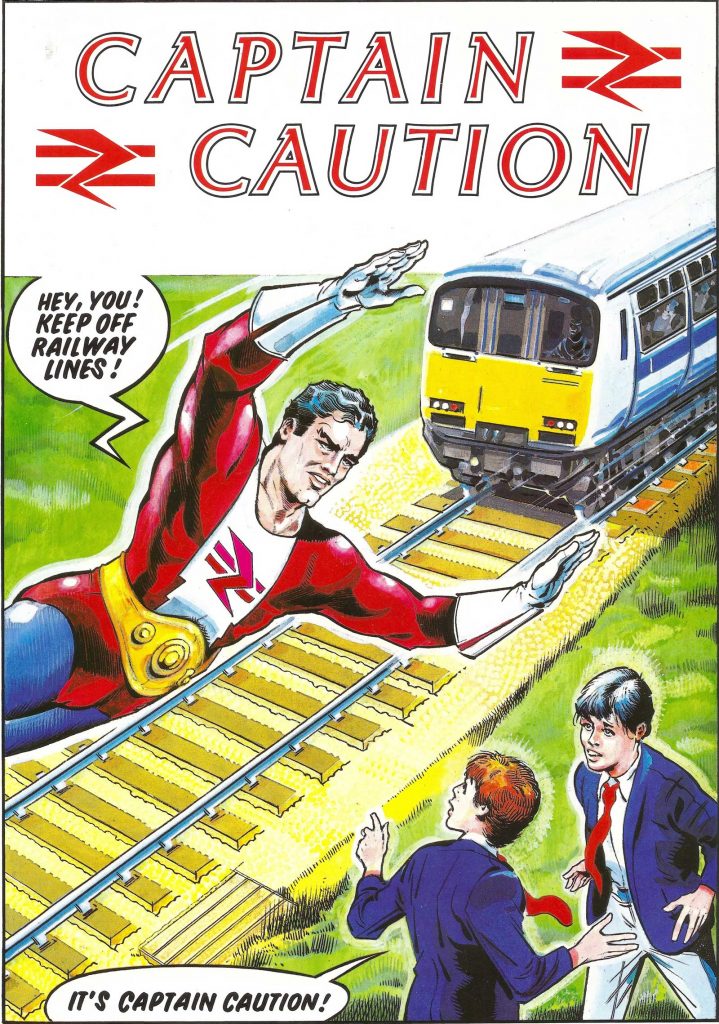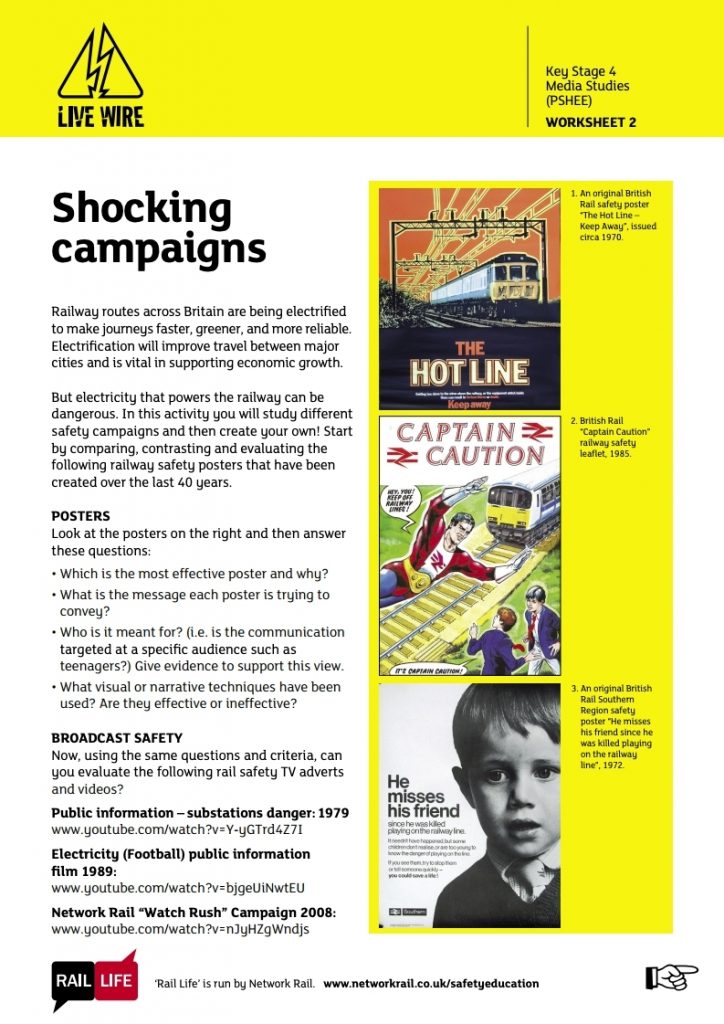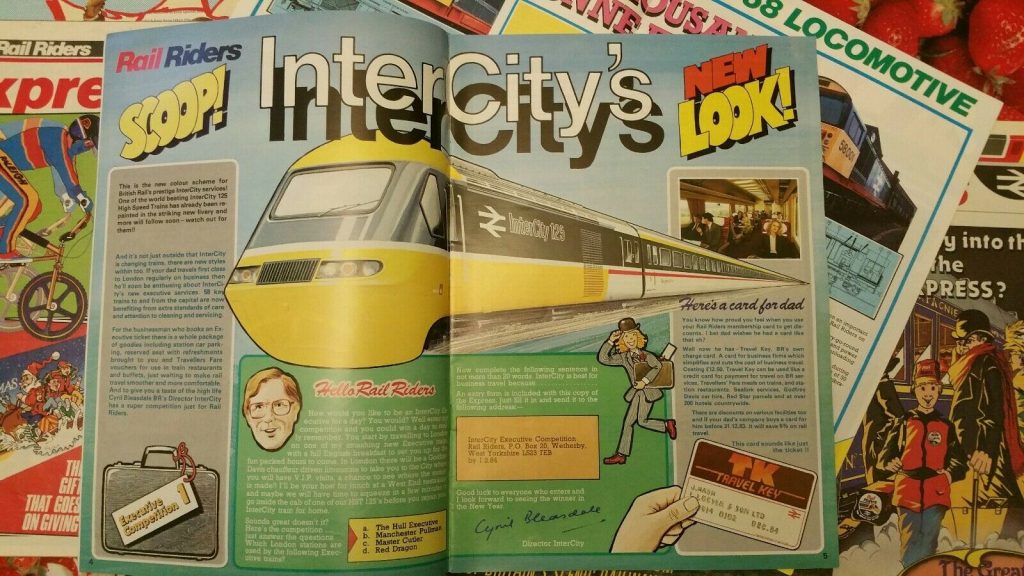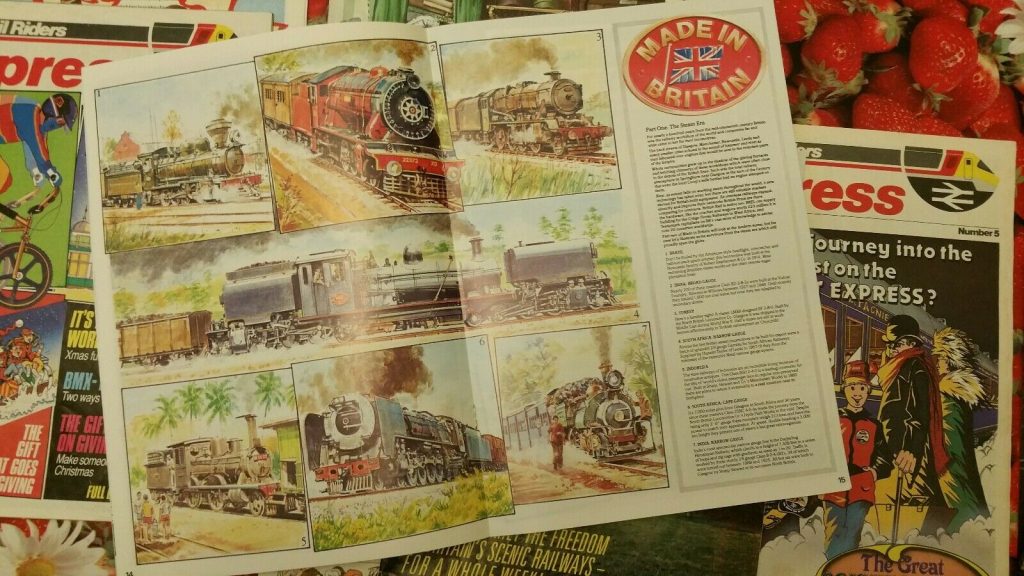Back in 1985, National Rail came up with a superhero-inspired promotion, no doubt in the hope that Captain Caution would do for rail safety what the Green Cross Man had been doing to encourage kids to be careful crossing roads.

British Rail’s “Captain Caution” appeared in a railway safety leaflet released in 1985. Art by Ron Smith
The still nationalised National Rail commissioned 2000AD Ron Smith – then working on the daily “Judge Dredd” strip for the Daily Star – to create the look for a for the flying character, seen here saving two New Engine Desperados from the line of death!
The look doesn’t quite work – whoever developed the project clearly thought an Enid Blyton schoolboy look to the potential trespassers was a great idea, despite the fashions of most genuine teenagers of the day. Still, either Ron or the ad agency came up with an interesting take on the British Rail double arrow logo that is still in use to denote Britain’s railways for Captain Caution’s emblem – counter to all the usual restrictions on changing it.
While Captain Caution made only the briefest of appearances in the world of British “Custom Comics”, the cover of the flyer still features in a Network Rail Safety Education pack for schools.

National Rail “Shocking Campaigns” Media – available as a PDF
British Rail didn’t just have Captain Caution saving kids from harm in the 1980s, of course – there was also the Rail Riders young rail enthusiasts club, originally called Great Rail Club, run by British Rail between 1981 and 1991, promoted by Keith Chegwin. It had its own quarterly magazine, Rail Riders Express.

Rail Riders Express Magazines, Image via eBay




The magazine featured some great art worthy of appearance in Eagle, Look and Learn or other such titles, cartoon characters dressing feature pages – and, we understand, its own comic strip starring BR’s chief test driver, Ben Stacey, although as yet we’ve been unable to find examples of this so it’s possible the character featured in text stories.
Former members recall he had a big “BR” emblazoned on his chest and was there to combat trespass and vandalism. He saved the Forth Bridge from being stolen by aliens, rescued the Maglev on the moon and more.
Membership of Rail Riders also entitled children aged 5-15 to discounted rail travel and free entry to the Rail Riders World model railway exhibit that used to be sited at York railway station, but closed in 2011 after British Rail was privatised and was moved by its owner William Heron to Hemswell Cliff in Lincolnshire, now operating as the Gainsborough Model Railway.
The club sponsored two Class 47 locomotives, one from 1981 to 1988 and another from 1988 to 1992, named 47406 Rail Riders and 47488 Rail Riders.
• Do you have copies of Rail Riders featuring the Ben Stacey stories? Let us know!
WEB LINKS
• Bear Alley has small examples of the Captain Caution Custom Comic strip here, courtesy of Richard Sheaf
• The Southern Railway Publicity Site has images of various Rail Clubs of the past here, including the Sea Link Club and Rail Riders
• There’s a terrific archive of British Rail ephemera here on Flickr, curated by Mike Ashworth – and an album of Railway Publicity here
• Red Carpet Prints offers facsimile prints of “Captain Caution” on eBay
• Bufferbeam offers replica Rail Riders merchandise on its web site
The founder of downthetubes, which he established in 1998. John works as a comics and magazine editor, writer, and on promotional work for the Lakes International Comic Art Festival. He is currently editor of Star Trek Explorer, published by Titan – his third tour of duty on the title originally titled Star Trek Magazine.
Working in British comics publishing since the 1980s, his credits include editor of titles such as Doctor Who Magazine, Babylon 5 Magazine, and more. He also edited the comics anthology STRIP Magazine and edited several audio comics for ROK Comics. He has also edited several comic collections, including volumes of “Charley’s War” and “Dan Dare”.
He’s the writer of “Pilgrim: Secrets and Lies” for B7 Comics; “Crucible”, a creator-owned project with 2000AD artist Smuzz; and “Death Duty” and “Skow Dogs” with Dave Hailwood.
Categories: British Comics, downthetubes Comics News, downthetubes News
 The SEQUENT’ULL Interviews: Dan White
The SEQUENT’ULL Interviews: Dan White  Sports comic highlights an immortal rugby match
Sports comic highlights an immortal rugby match  In Review: The Leopard from Lime Street – Birthright
In Review: The Leopard from Lime Street – Birthright  New thrills aplenty in this week’s 2000AD!
New thrills aplenty in this week’s 2000AD!
It’s strange the warnings about electric trains came when overhead wire electrification was the main way of electrifying non-electric lines, and the long-in-existence third rail networks were potentially a lot more dangerous.
The third rail to Dorset was about the only new stretch of line to be so treated.
Finally fished out my copies of Rail Riders – I have 3 issues with Ben Racey in; plus some Dick Millington art; look out for it on the blog soon
The railway safety film Eighteen also shows only an overhead wire electrified line.
As I have said before, the lack of warning about the dangers of third-rail electrification surprises me. Was it the speeding up of services with the introduction of overhead electrified routes that was in the minds of the those behind these railway comic characters, rather than the electrification itself? Someone killed himself in 2017 after climbing onto the roof of a train in Manchester. Another similar death in Scotland in 2018.
As you know, the extensive southern third rail electric network covers south London and the southern counties of Dorset, Hampshire, Sussex, Surrey and Kent, as do two lines of the Merseyrail network, the Northern Line and the Wirral Line, which use 750 V DC third rail; if I recall correctly, the Isle of Wight line also uses third rail electrification, as does the Docklands Light Railway.
Network Rail has specific cautions about the dangers of third rail, but not as comics, see http://www.networkrail.co.uk/stories/you-vs-train-the-third-rail; and overall, more lines utilise overhead electrifcation so perhaps that was why the focus was on these?
There is no actual breakdown I can find for the number of deaths on UK railways caused by electrification methods – either overhead or third rail. Rail Safety Statistics – 2018-19 Annual Statistical Release (PDF) – indicate the number of passenger fatalities increased to 17 in 2018-19 – an increase from 9 in 2017-18. This is the highest number in the last ten years. However, there were no passenger fatalities as a result of a train accident in 2018-19
Many thanks, John, for your detailed reply. Bearing in mind that anyone has to deliberately climb up or down to get close to an overhead 25,000 volt line – or throw something at one – to be in danger, whereas just by trespassing on a third-rail route one can get killed, the comparative lack of safety material is not proportionate to the risk. Although, I cannot recall – from over sixty years of studying railway transport – of reading of any deaths by trespassers on third-rail systems; I expect they have happened. Looking at the figures in the report you mention, they seem to reflect the increase in train use over the past decade or so. I receive the Rail Accident Investigation Board reports, and most accidents are from deliberate misuse of crossings, both pedestrian and vehicular, and by staff ignoring or misreading all the reams of documentation that now accompany any work on the line. People ignoring crossing procedures is so common; two loco drivers on the Rhomney Hythe & Dymchurch Railway were killed by motorists driving through flashing red lights; two teenage girls ignored the flashing red lights at a foot crossing, and got killed; crossing CCTV cameras show that driving round lowered barriers is almost a daily occurrence – a current You Tube video shows a lorry driver crashing through a lowered barrier at some 20 mph. Two track workers were killed when it was decided not to post the required lookout.
A different – and proven to be fatal – type of accident has happened when passengers have had straps, buckles, etc get caught between closing coach doors. The rubber strip obstruction detectors are not sensitive enough to stop the closed light showing on the driver’s or guard’s control panel – and passengers have been dragged along by the departing train – or tram. One woman has been killed, and other people seriously injured by what are, to be honest, dangerous but passed as safe ‘state-of-the-art’ sliding doors.
Going back to third-rail, some overseas systems have the contact shoes on the train running against the underneath of the power rail. This means that the top and outer sides of the rail can have protective insulation, and that leaves and ice will not create barriers to good conductivity between the rail and the pickup shoes. No need for leaf and ice clearing trains during the autumn and winter seasons.
As ever, safety is relative.
Thanks for this, Eric. The Courts and Tribunals web site lists all Railway Related Death-related coroner reports at http://www.judiciary.uk/subject/railway-related-deaths with links to redacted PDFs, but it would, it appear, going through every single one to confirm the circumstances of each death and only some specifically indicate whether a death is self inflicted or accidental. In some instances coroners of course recommend action – for example, the changing of a crossing – but there is clearly much need for safety promotion, which these comics attempted, and more recently with the “Eighteen” initiative, which as you know, I reported on here